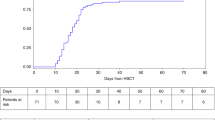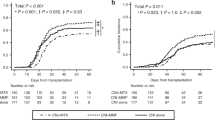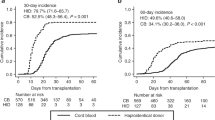Abstract
Hematopoietic stem cell transplantation (HSCT) is the standard of care in children with Hurler syndrome (HS) as it is the only therapy that can arrest disease progression. We examined the incidence, patterns and outcomes of graft failure in all HS children undergoing first HSCT at the Royal Manchester Children’s Hospital or the University of Minnesota Children’s Hospital from 1983 to 2016. Implementation of busulfan pharmacokinetic monitoring started in 2004 in both institutions. Two hundred and forty HS children were included in this analysis (historical era (pre-2004), n=131; current era (post 2004), n=109). The proportion of patients with graft failure was significantly lower in the current era compared with the historical era (37.2% vs 10.1%, respectively). Of 49 patients with graft failure in the historical era, 1 had aplasia and 48 had autologous reconstitution. All the 11 graft failures of the current era occurred in recipients of cord blood transplants (7 aplasia and 4 autologous reconstitution). The outcomes of second transplant in these patients has improved, with 89% of such patients alive and engrafted in the current era compared with 58% in the historical era. The pattern of graft failure has changed from autologous reconstitution, likely secondary to inadequate myelosuppression in the historical era, to aplasia in the current era, likely due to imperfect immunosuppression.
This is a preview of subscription content, access via your institution
Access options
Subscribe to this journal
Receive 12 print issues and online access
$259.00 per year
only $21.58 per issue
Buy this article
- Purchase on Springer Link
- Instant access to full article PDF
Prices may be subject to local taxes which are calculated during checkout


Similar content being viewed by others
References
Meikle PJ, Hopwood JJ, Clague AE, Carey WF . Prevalence of lysosomal storage disorders. JAMA 1999; 281: 249–254.
Fratantoni JC, Hall CW, Neufeld EF . The defect in Hurler and Hunter syndromes. II. Deficiency of specific factors involved in mucopolysaccharide degradation. Proc Natl Acad Sci USA 1969; 64: 360–366.
Fratantoni JC, Hall CW, Neufeld EF . Hurler and Hunter syndromes: mutual correction of the defect in cultured fibroblasts. Science 1968; 162: 570–572.
Whitley CB, Belani KG, Chang PN, Summers CG, Blazar BR, Tsai MY et al. Long-term outcome of Hurler syndrome following bone marrow transplantation. Am J Med Genet 1993; 46: 209–218.
Peters C, Balthazor M, Shapiro EG, King RJ, Kollman C, Hegland JD et al. Outcome of unrelated donor bone marrow transplantation in 40 children with Hurler syndrome. Blood 1996; 87: 4894–4902.
Peters C, Shapiro EG, Anderson J, Henslee-Downey PJ, Klemperer MR, Cowan MJ et al. Hurler syndrome: II. Outcome of HLA-genotypically identical sibling and HLA-haploidentical related donor bone marrow transplantation in fifty-four children. The Storage Disease Collaborative Study Group. Blood 1998; 91: 2601–2608.
Souillet G, Guffon N, Maire I, Pujol M, Taylor P, Sevin F et al. Outcome of 27 patients with Hurler's syndrome transplanted from either related or unrelated haematopoietic stem cell sources. Bone Marrow Transplant 2003; 31: 1105–1117.
Aldenhoven M, Jones SA, Bonney D, Borrill RE, Coussons M, Mercer J et al. Hematopoietic cell transplantation for mucopolysaccharidosis patients is safe and effective: results after implementation of international guidelines. Biol Blood Marrow Transplant 2015; 21: 1106–1109.
Staba SL, Escolar ML, Poe M, Kim Y, Martin PL, Szabolcs P et al. Cord-blood transplants from unrelated donors in patients with Hurler's syndrome. N Engl J Med 2004; 350: 1960–1969.
Boelens JJ, Wynn RF, O'Meara A, Veys P, Bertrand Y, Souillet G et al. Outcomes of hematopoietic stem cell transplantation for Hurler's syndrome in Europe: a risk factor analysis for graft failure. Bone Marrow Transplant 2007; 40: 225–233.
Wilkinson FL, Sergijenko A, Langford-Smith KJ, Malinowska M, Wynn RF, Bigger BW . Busulfan conditioning enhances engraftment of hematopoietic donor-derived cells in the brain compared with irradiation. Mol Ther 2013; 21: 868–876.
Boelens JJ, Aldenhoven M, Purtill D, Ruggeri A, Defor T, Wynn R et al. Outcomes of transplantation using various hematopoietic cell sources in children with Hurler syndrome after myeloablative conditioning. Blood 2013; 121: 3981–3987.
Ghosh A, Miller W, Orchard PJ, Jones SA, Mercer J, Church HJ et al. Enzyme replacement therapy prior to haematopoietic stem cell transplantation in Mucopolysaccharidosis Type I: 10year combined experience of 2 centres. Mol Genet Metab 2016; 117: 373–377.
Wiseman DH, Mercer J, Tylee K, Malaiya N, Bonney DK, Jones SA et al. Management of mucopolysaccharidosis type IH (Hurler's syndrome) presenting in infancy with severe dilated cardiomyopathy: a single institution's experience. J Inherit Metab Dis 2013; 36: 263–270.
Ben-Barouch S, Cohen O, Vidal L, Avivi I, Ram R . Busulfan fludarabine vs busulfan cyclophosphamide as a preparative regimen before allogeneic hematopoietic cell transplantation: systematic review and meta-analysis. Bone Marrow Transplant 2016; 51: 232–240.
Ruggeri A, Eapen M, Scaravadou A, Cairo MS, Bhatia M, Kurtzberg J et al. Umbilical cord blood transplantation for children with thalassemia and sickle cell disease. Biol Blood Marrow Transplant 2011; 17: 1375–1382.
Liu HL, Sun ZM, Geng LQ, Wang XB, Ding KY, Tang BI et al. Unrelated cord blood transplantation for newly diagnosed patients with severe acquired aplastic anemia using a reduced-intensity conditioning: high graft rejection, but good survival. Bone Marrow Transplant 2012; 47: 1186–1190.
Kuwatsuka Y, Kanda J, Yamazaki H, Mori T, Miyamura K, Kako S et al. A comparison of outcomes for cord blood transplantation and unrelated bone marrow transplantation in adult aplastic anemia. Biol Blood Marrow Transplant 2016; 22: 1836–1843.
Bizzetto R, Bonfim C, Rocha V, Socie G, Locatelli F, Chan K et al. Outcomes after related and unrelated umbilical cord blood transplantation for hereditary bone marrow failure syndromes other than Fanconi anemia. Haematologica 2011; 96: 134–141.
Admiraal R, van Kesteren C, Jol-van der Zijde CM, van Tol MJ, Bartelink IH, Bredius RG et al. Population pharmacokinetic modeling of Thymoglobulin((R)) in children receiving allogeneic-hematopoietic cell transplantation: towards improved survival through individualized dosing. Clin Pharmacokinet 2015; 54: 435–446.
Cairo MS, Tarek N, Lee DA, Delaney C . Cellular engineering and therapy in combination with cord blood allografting in pediatric recipients. Bone Marrow Transplant 2016; 51: 27–33.
Author information
Authors and Affiliations
Corresponding author
Ethics declarations
Competing interests
The authors declare no conflict of interest.
Additional information
Supplementary Information accompanies this paper on Bone Marrow Transplantation website
Supplementary information
Rights and permissions
About this article
Cite this article
Lum, S., Miller, W., Jones, S. et al. Changes in the incidence, patterns and outcomes of graft failure following hematopoietic stem cell transplantation for Hurler syndrome. Bone Marrow Transplant 52, 846–853 (2017). https://doi.org/10.1038/bmt.2017.5
Received:
Revised:
Accepted:
Published:
Issue Date:
DOI: https://doi.org/10.1038/bmt.2017.5
This article is cited by
-
Hematopoietic Stem Cell Transplantation for Storage Disorders: Present Status
Indian Journal of Pediatrics (2024)
-
B-cell depletion abrogates immune mediated cytopenia and rejection of cord blood transplantation in Hurler syndrome
Bone Marrow Transplantation (2022)
-
Enzyme replacement therapy and hematopoietic stem cell transplant: a new paradigm of treatment in Wolman disease
Orphanet Journal of Rare Diseases (2021)
-
Hematopoietic stem cell transplantation in children with Griscelli syndrome type 2: a single-center report on 35 patients
Bone Marrow Transplantation (2020)
-
Post-transplant laronidase augmentation for children with Hurler syndrome: biochemical outcomes
Scientific Reports (2019)



